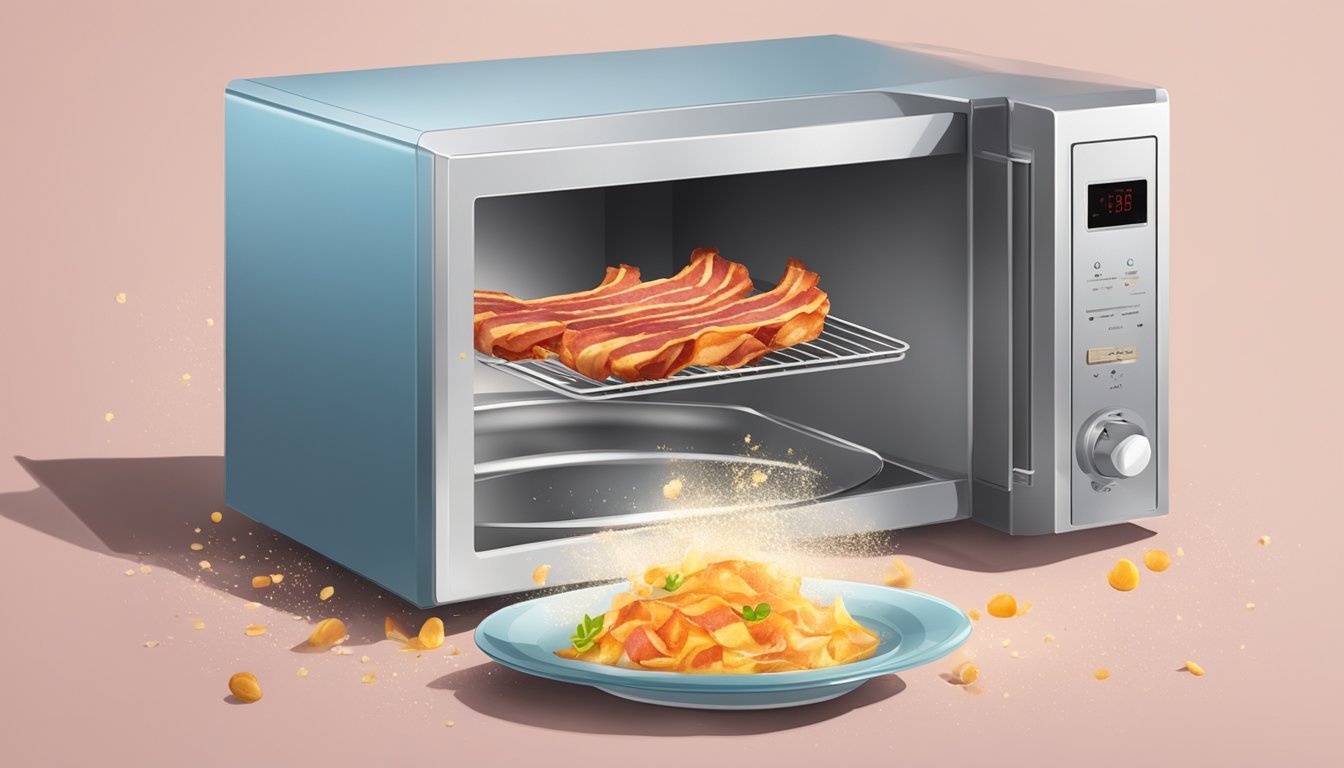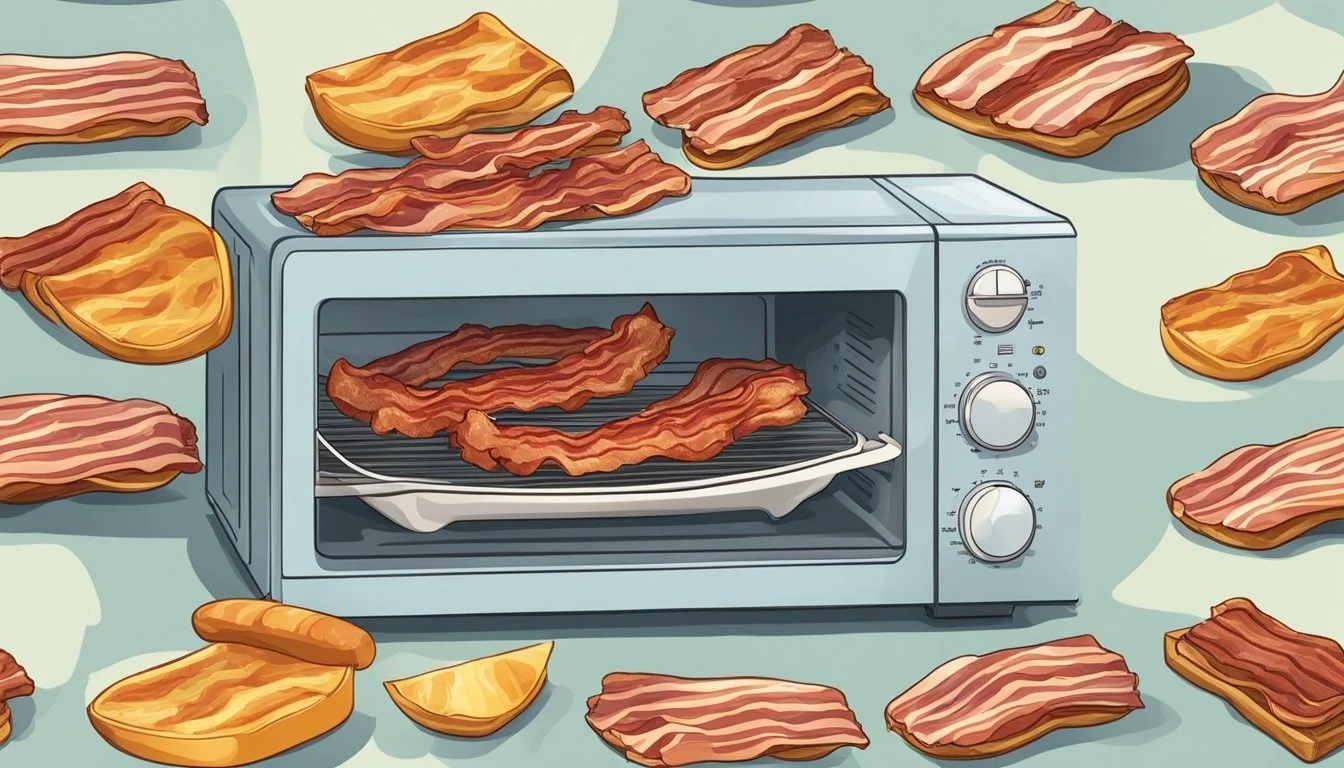How to Cook Bacon in the Microwave
Quick, Crispy, and Mess-Free
Cooking bacon in the microwave offers a quick and convenient alternative to traditional stovetop methods. This technique allows you to achieve crispy, delicious bacon without the mess and hassle of frying pans or grease splatters. Microwaving bacon takes about 3 minutes on high power, or approximately 30 seconds per slice.
To microwave bacon, start by lining a microwave-safe dish with paper towels. Arrange the bacon slices in a single layer on the paper towels, then cover with additional paper towels to absorb excess grease. This simple setup ensures crispy results while containing the fat for easy cleanup.
Microwaved bacon can be used in a variety of dishes, from breakfast sandwiches to salad toppings. The fast cooking time makes it perfect for busy mornings or last-minute meal additions. With this method, you can enjoy perfectly cooked bacon in minutes, saving time and energy in the kitchen.
Understanding Microwaves and Bacon
Microwaves and bacon have a unique relationship when it comes to cooking. The appliance's efficiency and the bacon's composition create a convenient method for preparing this popular breakfast meat.
Types of Bacon and Wattage Considerations
Different bacon varieties require specific cooking approaches in the microwave. Regular sliced bacon cooks quickly and evenly. Thick-cut bacon needs more time and may benefit from lower power settings to prevent burning.
Turkey bacon, being leaner, requires careful monitoring to avoid overcooking. Microwave wattage plays a crucial role in cooking times. Higher wattage ovens cook faster, while lower wattage models need more time.
A general guideline for cooking times:
Bacon Type 1000W Microwave 700W Microwave Regular 1 min/slice 1.5 min/slice Thick-cut 1.5 min/slice 2 min/slice Turkey 45 sec/slice 1 min/slice
Adjust times based on desired crispiness and microwave power.
Microwave Safety and Efficiency
Using microwave-safe plates or dishes is essential for cooking bacon safely. Ceramic, glass, and certain plastics labeled as microwave-safe are suitable options. Avoid metal containers or dishes with metallic trim.
Paper towels play a dual role in microwave bacon cooking. They absorb excess grease and prevent splattering, keeping the microwave clean. Place paper towels below and above the bacon slices.
For even cooking, arrange bacon in a single layer without overlapping. This ensures uniform heat distribution and consistent results. Some microwave-safe bacon trays elevate the meat, allowing grease to drip away.
Microwave bacon cooking is energy-efficient, using less electricity than stovetop or oven methods. It's also faster, taking only a few minutes to achieve crispy bacon.
Preparing to Cook Bacon in the Microwave
Proper preparation is key for successfully cooking bacon in the microwave. The right equipment and techniques ensure crispy, evenly cooked bacon with minimal mess.
Selecting the Right Equipment
Choose a microwave-safe plate large enough to accommodate the bacon strips in a single layer. Glass or ceramic dishes work well. Avoid metal containers, which can cause sparking.
Line the plate with paper towels to absorb excess grease. Use 2-3 layers for optimal absorption. Some cooks prefer microwave-safe bacon trays with ridges to elevate the bacon.
Keep tongs or a fork handy for safely removing hot bacon from the microwave. A splatter cover can help contain grease and prevent splattering inside the microwave.
Bacon Preparation Techniques
Select high-quality bacon strips of uniform thickness for even cooking. Thick-cut bacon may require longer cooking times.
Separate the bacon slices and arrange them in a single layer on the prepared plate. Avoid overlapping to ensure each piece cooks evenly.
For crispier bacon, place additional paper towels on top of the arranged strips. This helps absorb moisture during cooking.
If desired, cut bacon strips in half to fit more pieces on the plate. Trim excess fat to reduce grease and potential flare-ups.
Experiment with different bacon varieties, such as applewood-smoked or peppered, for varied flavors. Always handle raw bacon with clean utensils to prevent contamination.
The Cooking Process
Microwaving bacon requires careful arrangement and timing to achieve optimal results. Proper placement and monitoring ensure evenly cooked, crispy bacon without mess or fuss.
Arranging the Bacon for Even Cooking
Place a microwave-safe plate or bacon tray in the microwave. Line it with paper towels to absorb excess grease. Lay bacon strips in a single layer, ensuring they don't overlap. This allows for even cooking and prevents some pieces from remaining undercooked.
For larger batches, cook bacon in multiple rounds rather than stacking. If using a bacon tray, follow its specific instructions for optimal placement.
Determining Cooking Time and Doneness
Cooking time varies based on microwave wattage, bacon thickness, and desired crispness. Start with 30-45 seconds per slice on high power. For example, 4 slices typically need 2-3 minutes.
Check bacon halfway through cooking and rotate the plate if needed. Add time in 30-second increments until desired doneness is reached. Bacon will continue to crisp slightly after removal.
For crispy bacon, cook until it turns golden brown. For chewier bacon, remove it when it's still slightly pliable. Let bacon rest on fresh paper towels for 1 minute before serving to absorb excess grease.
Safety and Cleanup Tips
Cooking bacon in the microwave requires careful attention to safety and efficient cleanup practices. Proper handling of hot grease and effective cleaning methods ensure a safe and hassle-free experience.
Handling Hot Grease and Avoiding Splatters
Use microwave-safe dishes with raised edges to contain bacon grease. Place paper towels both under and over the bacon to absorb excess fat. This reduces splattering and makes cleanup easier.
Keep hands protected when removing hot dishes. Use oven mitts or thick towels to avoid burns. Let bacon cool slightly before handling to prevent grease burns.
To minimize splatters, cover bacon with a microwave-safe lid or paper towel. Avoid overcooking, which can cause excessive popping and splattering. Check bacon frequently and adjust cooking time as needed.
Efficient Cleanup Strategies
Remove excess grease promptly while still warm. Pour cooled grease into a heat-safe container for disposal, not down the drain. Wipe remaining grease with paper towels before washing the dish.
Clean the microwave interior immediately after cooking. Wipe down walls and turntable with a damp cloth or sponge. For stubborn grease, heat a bowl of water and lemon juice in the microwave for 3-5 minutes. The steam will loosen grease for easy wiping.
Dispose of used paper towels in the trash. Wash microwave-safe dishes with hot, soapy water. For persistent grease, soak dishes before washing. Regular cleaning prevents grease buildup and maintains a hygienic cooking environment.
Enjoying Your Microwaved Bacon
Microwaved bacon offers a quick and convenient option for adding smoky flavor to meals. Proper resting enhances texture, while creative uses elevate breakfast dishes and other recipes.
Resting Bacon for Optimal Texture
After removing bacon from the microwave, let it rest for 30-60 seconds on a paper towel-lined plate. This brief pause allows excess grease to drain and the bacon to crisp up further. For even crispier results, transfer the bacon to a wire rack after initial blotting.
Avoid stacking hot bacon slices, as this can make them soggy. Instead, arrange in a single layer until ready to serve. If preparing bacon ahead of time, store cooled slices in an airtight container in the refrigerator for up to 5 days.
Incorporating Bacon into Meals
Crumble microwaved bacon over scrambled eggs or fold into omelets for a protein-packed breakfast. Sprinkle crispy bits on pancakes or French toast sticks for a sweet-savory combination. Add bacon to sandwiches, salads, or baked potatoes for a flavorful boost.
Try wrapping microwaved bacon around meatloaf before baking for extra taste and texture. Use it to top homemade pizza or stir into pasta dishes. For a unique twist, mix bacon pieces into waffle or cornbread batter before cooking.
Experiment with different bacon varieties like maple, applewood, or peppered for diverse flavors in your recipes. Remember that microwaved bacon works well in most dishes calling for pan-fried or oven-baked bacon.
Health Considerations and Alternatives
Microwaving bacon offers some health benefits compared to traditional cooking methods. It can reduce fat content while still providing a tasty result. Alternative cooking techniques also exist for those seeking different options.
Benefits of Microwave Cooking
Microwaving bacon can significantly reduce its fat content. The bacon cooks above the grease, allowing excess fat to drip away. This method may result in bacon with fewer calories and less saturated fat.
Microwave cooking also minimizes the formation of harmful compounds like polycyclic aromatic hydrocarbons. These substances can develop when meat is cooked at high temperatures over an open flame.
Using paper towels to absorb grease further reduces fat content in microwave-cooked bacon. This technique results in a healthier end product compared to pan-frying.
Alternative Cooking Methods
Oven-baking is a popular alternative for cooking bacon. It allows for even cooking and easy cleanup. Place bacon on a rack over a baking sheet to let fat drip away during cooking.
Air fryer bacon has gained popularity as a healthier option. The hot air circulation cooks bacon evenly while allowing fat to drip into the fryer's bottom tray.
Skillet cooking remains a classic method. Use a non-stick pan to reduce added fats. Drain cooked bacon on paper towels to remove excess grease.
For a very low-fat option, try Canadian bacon or turkey bacon. These alternatives contain less fat than traditional pork bacon while still providing a satisfying flavor.



